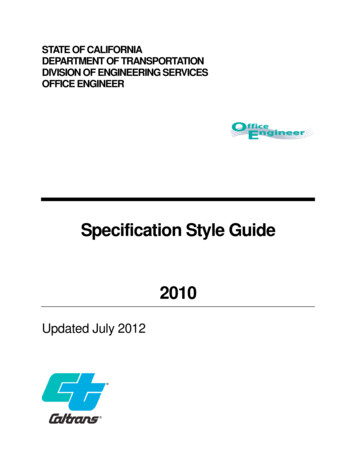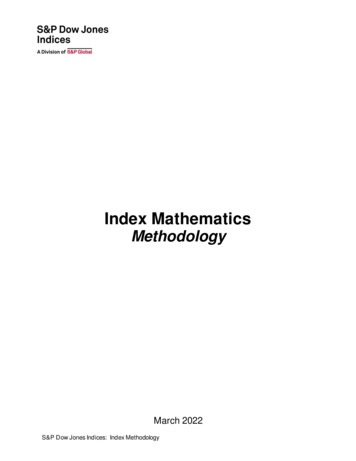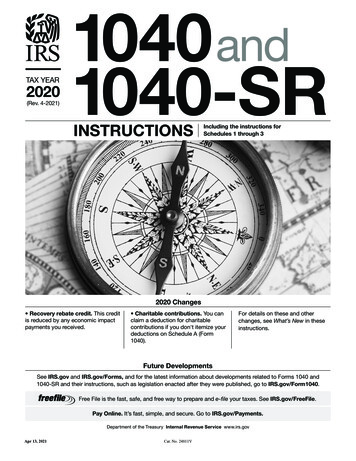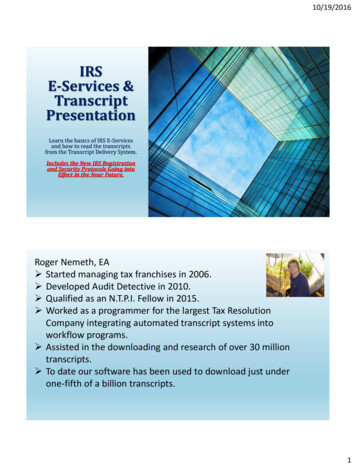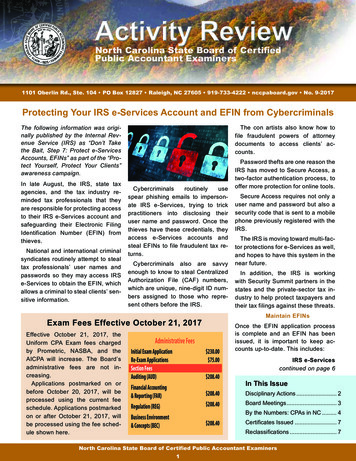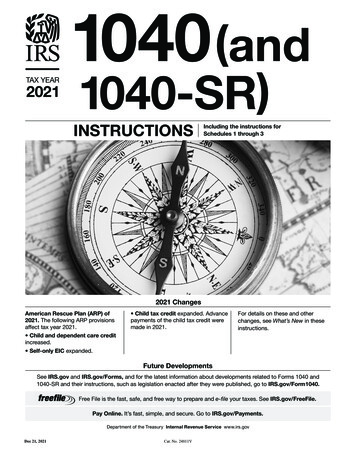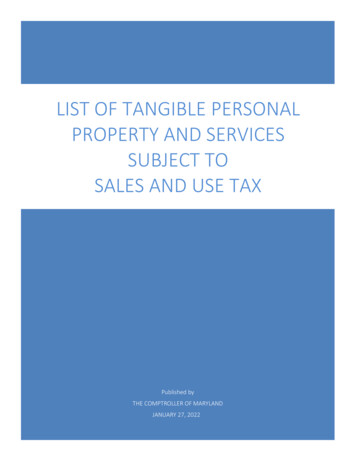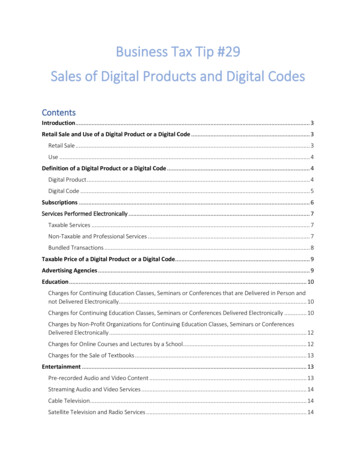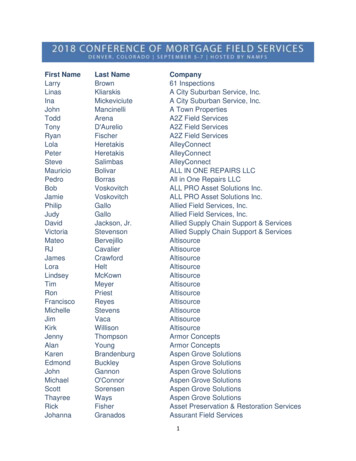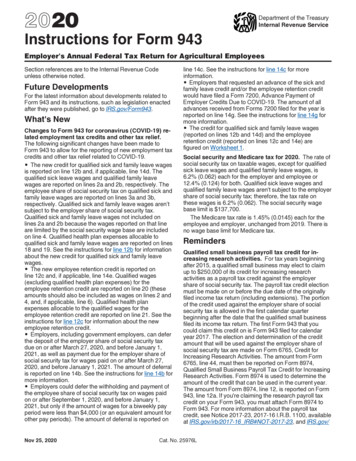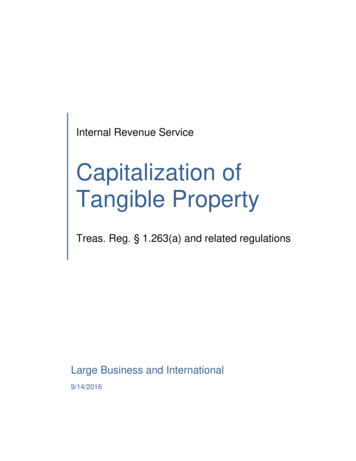
Transcription
Internal Revenue ServiceCapitalization ofTangible PropertyTreas. Reg. § 1.263(a) and related regulationsLarge Business and International9/14/2016
Table of ContentsCHAPTER 1 EXAMINATION OF TANGIBLE PROPERTY . iINTRODUCTION . 1CAPITALIZATION OF TANGIBLE PROPERTY – BACKGROUND . 1FINAL REGULATIONS - OVERVIEW . 3GENERAL TERMINOLOGY . 4CHAPTER 2 COMPLIANCE CONSIDERATIONS . 11IMPLEMENTATION OF THE REGULATIONS . 11CAPITALIZATION TO REPAIR STUDIES . 11STAND DOWN. 12STATISTICAL SAMPLING . 12INDUSTRY SPECIFIC GUIDANCE. 13COORDINATION WITH OTHER CODE SECTIONS . 15EXAMINATION CONSIDERATIONS . 19INTERVIEW QUESTIONS . 22CHAPTER 3 UNIT OF PROPERTY . 24INTRODUCTION . 24DETERMINING THE UOP . 24BUILDINGS . 26PROPERTY OTHER THAN BUILDINGS . 29COST SEGREGATION STUDIES. 31IMPROVEMENTS TO PROPERTY. 31ADDITIONAL RULES . 32AUDIT PROCEDURES . 33i Page
CHAPTER 4 AMOUNTS PAID TO ACQUIRE OR PRODUCEPROPERTY . 36INTRODUCTION . 36GENERAL RULES . 36EXCEPTIONS . 37DEFENSE OR PERFECTION OF TITLE . 37TRANSACTION COSTS . 37SPECIAL RULES . 39AUDIT PROCEDURES . 40CHAPTER 5 DE MINIMIS SAFE HARBOR . 42INTRODUCTION . 42SAFE HARBOR ELECTION. 42SAFE HARBOR REQUIREMENTS AND LIMITATIONS . 43APPLICABLE FINANCIAL STATEMENTS. 45ACCOUNTING POLICY . 45ADDITIONAL RULES . 47EXCEPTIONS TO THE SAFE HARBOR . 48ANTI-ABUSE RULE . 48AUDIT PROCEDURES . 49CHAPTER 6 IMPROVEMENT RULES – BETTERMENTS . 52IMPROVEMENTS IN GENERAL . 52BETTERMENTS . 52APPLICATION OF THE BETTERMENT RULES . 54AUDIT PROCEDURES . 57ii P a g e
CHAPTER 7 IMPROVEMENT RULES – RESTORATIONS . 60IMPROVEMENTS IN GENERAL . 60RESTORATIONS . 60REPLACEMENT OF A COMPONENT OF A UOP – LOSS DEDUCTED (NOT ACASUALTY LOSS). 61REPLACEMENT OF A COMPONENT OF A UOP – GAIN/LOSS REALIZED AND BASISADJUSTED . 62REPLACMENT OF A MAJOR COMPONENT/SUBSTANTIAL STRUCTURAL PART OF AUOP . 63RESTORATION OF DAMAGE FROM A CASUALTY LOSS. 67RETURNS THE UOP TO OPERATIONAL CONDITION – AFTER DETERIORATED ANDNON-FUNCTIONAL . 68REBUILDS TO LIKE-NEW CONDITION – AFTER THE END OF CLASS LIFE . 69AUDIT PROCEDURES . 70CHAPTER 8 IMPROVEMENT RULES – NEW OR DIFFERENTUSE . 74IMPROVEMENTS IN GENERAL . 74NEW OR DIFFERENT USE . 74AUDIT PROCEDURES . 76CHAPTER 9 SAFE HARBORS – SPECIAL RULES – OTHERPROVISIONS . 78INTRODUCTION . 78SAFE HARBOR FOR ROUTINE MAINTENANCE . 78SAFE HARBOR FOR SMALL TAXPAYERS . 82CERTAIN COSTS INCURRED DURING AN IMPROVEMENT . 84SPECIAL RULES FOR REMOVAL COSTS . 85OPTIONAL REGULATORY ACCOUNTING METHOD . 87iii P a g e
ELECTION TO CAPITALIZE REPAIR AND MAINTENANCE COSTS . 88ELECTION TO DEDUCT OR CAPITALIZE EXPENDITURES UNDER OTHER IRCSECTIONS . 89CHAPTER 10 MATERIALS AND SUPPLIES . 90INTRODUCTION . 90AMOUNTS PAID TO ACQUIRE OR PRODUCE A UNIT OF PROPERTY – EXCEPTIONFOR MATERIALS AND SUPPLIES . 90TIMING OF DEDUCTION FOR MATERIALS AND SUPPLIES . 90DEFINITION OF MATERIALS AND SUPPLIES . 91COORDINATION OF §§ 263(a) and 263A . 92ROTABLE, TEMPORARY, AND STANDBY EMERGENCY SPARE PARTS . 93ELECTION TO CAPITALIZE AND DEPRECIATE ROTABLE, TEMPORARY, ANDEMERGENCY SPARE PARTS . 94OPTIONAL METHOD OF ACCOUNTING FOR ROTABLE AND TEMPORARY SPAREPARTS . 95DE MINIMIS SAFE HARBOR ELECTION . 96ACCOUNTING METHOD CHANGES AND EFFECTIVE DATES . 96MATERIALS AND SUPPLIES SUMMARY. 98AUDIT PROCEDURES . 99CHAPTER 11 LEASED PROPERTY . 102INTRODUCTION . 102LEASEHOLD IMPROVEMENTS UNDER THE FINAL REGULATIONS . 102COORDINATION WITH SECTION 263A . 103LEASEHOLD IMPROVEMENT OR ACQUISITION OF TANGIBLE PROPERTY? . 103LEASED BUILDING PROPERTY. 103LEASED PROPERY OTHER THAN BUILDINGS . 105COST RECOVERY FOR LEASEHOLD IMPROVEMENTS . 106iv P a g e
AUDIT PROCEDURES . 107CHAPTER 12 DISPOSITION CONCEPTS AND MACRSACCOUNTING RULES . 109INTRODUCTION . 109DISPOSITION CONCEPTS . 109ACCOUNTING FOR MACRS PROPERTY . 114SPECIAL RULES FOR MULTIPLE ASSET ACCOUNTS . 118ACCOUNTING FOR DISPOSITIONS . 119ACCOUNTING METHOD. 120AUDIT PROCEDURES . 121CHAPTER 13 DISPOSITIONS IN GENERAL . 123INTRODUCTION . 123DEFINITION OF A DISPOSITION. 123DETERMINATION OF THE DISPOSED ASSET . 125AUDIT PROCEDURES . 127CHAPTER 14 MACRS DISPOSITION RULES . 131INTRODUCTION . 131DISPOSITIONS OF MACRS PROPERTY IN GENERAL. 131DISPOSITION OF A PORTION OF AN ASSET FROM AN SAA OR MAA . 133GAIN OR LOSS ON DISPOSITIONS OF MACRS PROPERTY . 137STATISTICAL SAMPLING . 140AUDIT PROCEDURES . 140CHAPTER 15 GENERAL ASSET ACCOUNT RULES . 145INTRODUCTION . 145ELECTION OF A GAA . 145v Page
ESTABLISHING A GAA . 145DISPOSITIONS FROM A GAA IN GENERAL . 147GAIN OR LOSS ON DISPOSITIONS FROM A GAA . 147GAA TERMINATIONS. 148AUDIT PROCEDURES . 152CHAPTER 16 ACCOUNTING METHOD CHANGES . 155METHODS OF ACCOUNTING – IN GENERAL . 155BACKGROUND . 156IDENTIFYING POTENTIAL AUDIT ISSUES . 161AUDIT PROCEDURES . 165CHAPTER 17 ACCOUNTING METHOD CHANGES CAPITALIZATION . 171APPLICABLE METHOD CHANGE PROCEDURES . 171SPECIFIC METHOD CHANGES TO COMPLY WITH THE FINAL CAPITALIZATIONREGULATIONS . 175CHANGES INCLUDED IN REV. PROC. 2015-14 AND REV. PROC. 2016-29. 179CHAPTER 18 ACCOUNTING METHOD CHANGES DEPRECIATION AND DISPOSITIONS . 180APPLICABLE METHOD CHANGE PROCEDURES . 180SPECIFIC METHOD CHANGES TO COMPLY WITH THE FINAL DEPRECIATION ANDDISPOSITION REGULATIONS . 185CHANGES IN REV. PROC. 2015-14, § 6.37 AND REV. PROC. 2016-29 § 6.14 . 189CHANGES INCLUDED IN REV. PROC. 2015-14, §§ 6.32 – 6.40 and REV. PROC. 201629, §§ 6.10 – 6.17 . 192vi P a g e
CHAPTER 1 EXAMINATION OF TANGIBLE PROPERTYINTRODUCTIONThis Audit Techniques Guide is for IRS examiners to use as a tool for identifying potentialtax issues. Examiners are advised to carefully risk assess and apply the law to the factsand circumstances for issues involving capitalization and dispositions of tangible property.The IRS and Treasury began a project in 2004, to revise the tangible property regulations.In anticipation of these regulations, many taxpayers changed their method of accountingbeginning as early as January 1, 2006. As a result, many of these taxpayers may now beusing a method of accounting for tax purposes that is inconsistent with the final regulations.On March 15, 2012, examiners were instructed in an LB&I directive to discontinue examining issues involving whether costs incurred to maintain, replace, or improve tangible property must be capitalized under § 263(a) and any correlative issues involving the dispositionof structural components of a building or dispositions of tangible depreciable assets. 1The final regulations were issued in 2013. Taxpayers are now required to correct any priormethod changes to comply with these regulations for tax years beginning on or after January 1, 2014. The burden of proof rests with the taxpayer, and sufficient contemporaneousrecords are required.CAPITALIZATION OF TANGIBLE PROPERTY – BACKGROUNDSection 263(a) denies a deduction for any amounts paid out for new buildings or for permanent improvements or betterments made to increase the value of any property or estate,or any amount expended in restoring property or in making good the exhaustion thereof forwhich an allowance is or has been made. Regulations previously issued under § 263(a)provided that capital expenditures included amounts paid to add to the value, or substantially prolong the useful life, of property owned by the taxpayer, or adapt the property to anew or different use. The regulations also provided that amounts paid for certain incidentalrepairs of property were not required to be capitalized. While § 263(a) generally requirestaxpayers to capitalize an amount paid to acquire, produce, or improve real or personaltangible property, § 263A generally prescribes that direct and allocable indirect costs mustbe capitalized to property produced by the taxpayer and property acquired for resale. Section 162 allows a current deduction for amounts paid or incurred for incidental repairs andmaintenance and does not require capitalization of these amounts.The United States Supreme Court has recognized the highly factual nature of determiningwhether expenditures are for capital improvements or for ordinary repairs. See Welch v.Helvering, 290 U.S. 111, 114 (1933) (“[T]he decisive distinctions [between capital and ordi1LB&I 04-0312-0041 Page
nary expenditures] are those of degree and not of kind”); Deputy v. du Pont, 308 U.S. 488,496 (1940) (observing that each case “turns on its special facts”). Because of the factualnature of the issue, the courts have articulated a number of ways to distinguish betweendeductible repairs and non-deductible capital improvements. For example: Illinois Merchants Trust Co. v. Commissioner, 4 B.T.A. 103, 106 (1926), the court explained that repair and maintenance expenses are incurred for the purpose of keepingproperty in an ordinarily efficient operating condition over its probable useful life for theuses for which the property was acquired. Capital expenditures, in contrast, are for replacements, alterations, improvements, or additions that appreciably prolong the life ofthe property, materially increase its value, or make it adaptable to a different use. Estate of Walling v. Commissioner, 373 F.2d 190, 192-193 (3rd Cir. 1967), the courtexplained that the relevant distinction between capital improvements and repairs iswhether the expenditures are to “put” or “keep” property in efficient operating condition. Plainfield-Union Water Co. v. Commissioner, 39 T.C. 333, 338 (1962), the court statedthat if the expenditure merely restores the property to the state it was in before the situation prompting the expenditure arose and does not make the property more valuable, more useful, or longer-lived, then such an expenditure is usually considered a deductible repair. In contrast, a capital expenditure is generally considered to be a morepermanent increment in the longevity, utility, or worth of the property.Over the years, the standards for applying § 263(a), as set forth in the regulations, caselaw, and administrative guidance, have proved to be difficult to discern and apply in practice and have led to considerable uncertainty and controversy. To address this discord, inJanuary of 2004, the IRS and Treasury announced their intention to propose regulationsproviding guidance in the area. See Notice 2004-6, (2004-3 IRB 308).On August 21, 2006, the IRS and the Treasury Department published proposed amendments to the regulations under § 263(a) (2006 proposed regulations) relating to amountspaid to acquire, produce, or improve tangible property. See REG-168745-03 (2006-39 C.B.532). The IRS and the Treasury Department received numerous written comments on the2006 proposed regulations and held a public hearing on December 19, 2006.After considering public comments, on March 10, 2008, the IRS and the Treasury Department withdrew the 2006 proposed regulations and published revised proposed regulations(2008 proposed regulations). See REG-168745-03 (2008-18 I.R.B. 871).After again receiving and considering public comments, in December 2011, the IRS and theTreasury Department withdrew the 2008 proposed regulations and issued temporary regulations effective for tax years beginning on or after January 1, 2012. See T.D. 9564. Theseregulations were issued as both temporary and proposed, allowing time for any additionalcomments from the public while permitting taxpayers and the IRS to rely on them.On December 17, 2012, the IRS published Notice 2012-73, (2012-51 I.R.B. 713, alertingtaxpayers that the IRS and the Treasury Department expected to issue final regulations re2 Page
garding the deduction and capitalization of expenditures related to tangible property in2013, and that the IRS and the Treasury Department anticipated that the final regulationswould contain changes from the temporary regulations.Technical amendments to the temporary regulations (T.D. 9564) were released on December 17, 2012, which amended the applicability date of the 2011 temporary regulations totaxable years beginning on or after January 1, 2014, while permitting taxpayers to chooseto apply the temporary regulations for taxable years beginning on or after January 1, 2012,and before the applicability date of the final regulations.On September 19, 2013, the IRS and the Treasury Department published final regulations(T.D. 9636) and removed the 2011 temporary and proposed regulations. The final regulations generally apply to taxable years beginning on or after January 1, 2014, however taxpayers may elect to apply the final regulations, or certain sections thereof, to taxable yearsbeginning on or after January 1, 2012.FINAL REGULATIONS - OVERVIEWSection 263(a) generally requires taxpayers to capitalize an amount paid to acquire, produce, or improve tangible property. The final regulations provide a general framework fordistinguishing capital expenditures from supplies, repairs, maintenance, and other deductible business expenses. The final regulations collectively are known as the “Tangible Property Regulations.” § 1.263(a)-1 provides general rules for capital expenditures, including an election toutilize a de minimis safe harbor. § 1.263(a)-2 provides rules for amounts paid for the acquisition or production of tangible property; and § 1.263(a)-3 provides rules for amounts paid for the improvement of tangible property.Changes were made to related regulations to correspond with changes made in the finalregulations. For example, the final regulations revise the definition and treatment of materials and supplies under § 1.162-3, and permit taxpayers to elect to capitalize and depreciateamounts paid for certain materials and supplies. If the de minimis safe harbor is elected, itapplies to most eligible materials and supplies property. The rules for repairs contained in§ 1.162-4, are amended to be consistent with the capitalization rules. Section 1.162-4 provides that a taxpayer is permitted to deduct amounts paid to repair and maintain tangibleproperty provided that such amounts are not required to be capitalized under § 263(a).These final regulations also amend the general rules for rental and leased property(§§1.162-11 and 1.167(a)-4) and provide for coordination with § 263A.Revisions for dispositions of property subject to § 168 are also included with changes to§ 1.168(i)-8 to include the retirement of a structural component of a building. These finalregulations also contain changes to § 1.167(a)-7 accounting for depreciable property,§ 1.167(a)-8 concerning retirements and § 1.168(i) accounting for general asset accounts.3 Page
We will explore these changes in this Audit Technique Guide. It is our goal to provide thereader with information on the implementation and applicability of these final regulationsand to offer insight regarding procedures and techniques available to examiners to ensurecompliance of LB&I taxpayers.GENERAL TERMINOLOGYConceptAuthorityAmeliorates Material Condition or Defect - A taxpayer mustcapitalize as an improvement an amount paid for a bettermentof a unit of property, including if it ameliorates a material condition or defect that either existed prior to the taxpayer’s acquisition of a UOP or arose during the production of the UOP. Thisapplies whether or not the taxpayer was aware of the conditionor defect at the time of acquisition or ,Examples 1-5Applicable Financial Statements (AFS) - Taxpayers financialstatement listed in highest priority order:1. A financial statement required to be filed with the Securitiesand Exchange Commission (SEC) which includes a Form10-K or Annual Statement to Shareholders;2. A certified audited financial statement that is accompaniedby the report of an independent certified public accountant(or a similar foreign professional) that is used for:a. Credit purposes;b. Reporting to shareholders; orc. Any other substantial non-tax purpose; or3. A financial statement, other than a tax return that is requiredto be provided to the federal or state government or anyfederal or state agency, other than to the IRS or the SEC.§1.263(a)-1(f)(4)Betterments - A taxpayer must capitalize as an improvementan amount paid for a betterment to a UOP. An amount is paidfor a betterment if it:1. Ameliorates a material condition or defect that either existedprior to the taxpayer’s acquisition of the UOP or arose duringthe production of the UOP, whether or not the taxpayer wasaware of the condition or defect at the time of acquisition orproduction;2. Is for a material addition, including a physical enlargement,expansion, extension, or addition of a major component tothe UOP or a material increase in the capacity, including additional cubic or linear space, of the UOP; or3. Is reasonably expected to materially increase the productivi-§1.263(a)-3(j)(1)4 Page
ty, efficiency, strength, quality, or output of the unit.De minimis - A safe harbor annual election that hinges on thetaxpayers accounting policy and permits taxpayers to treatitems for tax as it would for books provided1. The cost does not exceed 5000 for taxpayers with applicable financial statements (AFS) or 2500 ( 500 for amountsincurred prior to January 1, 2016) for taxpayers without AFSper invoice or per item, or2. The economic useful life of the property does not exceed 12months.Additional rules and exceptions apply.§ 1.263(a)-1(f)Functionally Interdependent – Components of property arefunctionally interdependent if the placing in service of one component by the taxpayer is dependent on the placing in service ofthe other component by the taxpayer.§ 1.263(a)-3(d)(3)(i)Major Component/Substantial Structural Part - A taxpayermust capitalize as an improvement amounts paid to restore aUOP, including when it is for the replacement of a part or acombination of parts that comprise a major component or asubstantial structural part of a UOP. One must consider all thefacts and circumstances, including the quantitative and qualitative significance of the part or combination of parts in relation tothe UOP. A major component is a part or combination of partsthat performs a discrete and critical function in the operation ofthe UOP. A substantial structural part is a part or combination ofparts that comprises a large portion of the physical structure ofthe UOP.§ 1.263(a)-3(k)(1)(vi)§ 1.263(a)-3(k)(6)§ 1.263(a)-3(k)(7),Examples 10-29Like-New Condition - A taxpayer must capitalize as an improvement amounts paid to restore a UOP, including where itresults in the rebuilding of the UOP to a like-new condition afterthe end of its class life. A UOP is rebuilt to a like-new conditionif it is brought to the status of new, rebuilt, remanufactured, or asimilar status under the terms of any federal regulatory guideline or the manufacturer’s original specifications. The class lifeof a UOP is defined under § 168(g)(2) and (3). Note that onlythe class life of a UOP may be used, not the economic usefullife.§ 1.263(a)-3(k)(1)(v)§ 1.263(a)-3(k)(5)§ 1.263(a)-3(k)(7),Examples 7-9Materials & Supplies - Generally, amounts paid to acquire orproduce non-incidental materials and supplies are deductible inthe taxable year in which the materials and supplies are firstused or consumed in the taxpayer’s operations. Incidental materials and supplies that are carried on hand and for which no§ 1.162-3(a) and (c)§ 1.162-3(h),Examples 1-145 Page
record of consumption is kept or of which physical inventories atthe beginning and end of the year are not taken, are deductiblein the taxable year in which these amounts are paid, providedtaxable income is clearly reflected.A material or supply is tangible property that is used or consumed in the taxpayer’s operations that is not inventory andthat:1. Is a component acquired to maintain, repair, or improve aUOP owned, leased, or serviced by the taxpayer and that isnot acquired as part of any UOP;2. Consists of fuel, lubricants, water, and similar items, reasonably expected to be cons
ductible repair. In contrast, a capital expenditure is generally considered to be a more permanent increment in the longevity, utility, or worth of the property. Over the years, the standards for applying § 263(a), as set forth in the regulations, case law, and administrative guidance, have proved to be difficult to discern and apply in prac-
